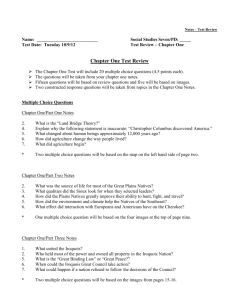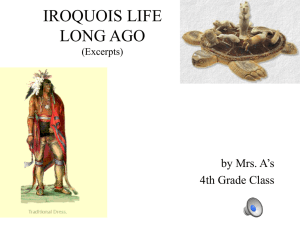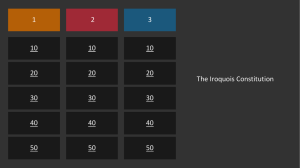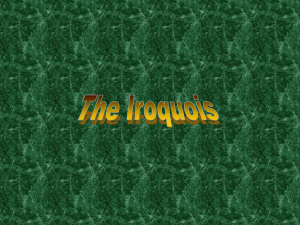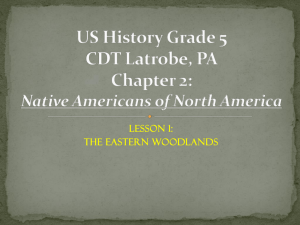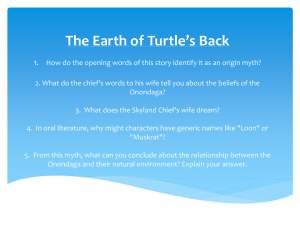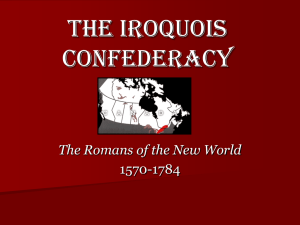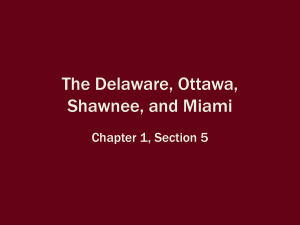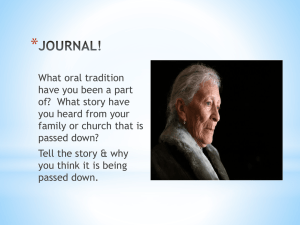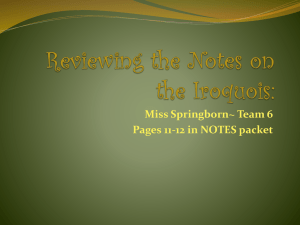Native American Religion - Garnet Valley School District
advertisement
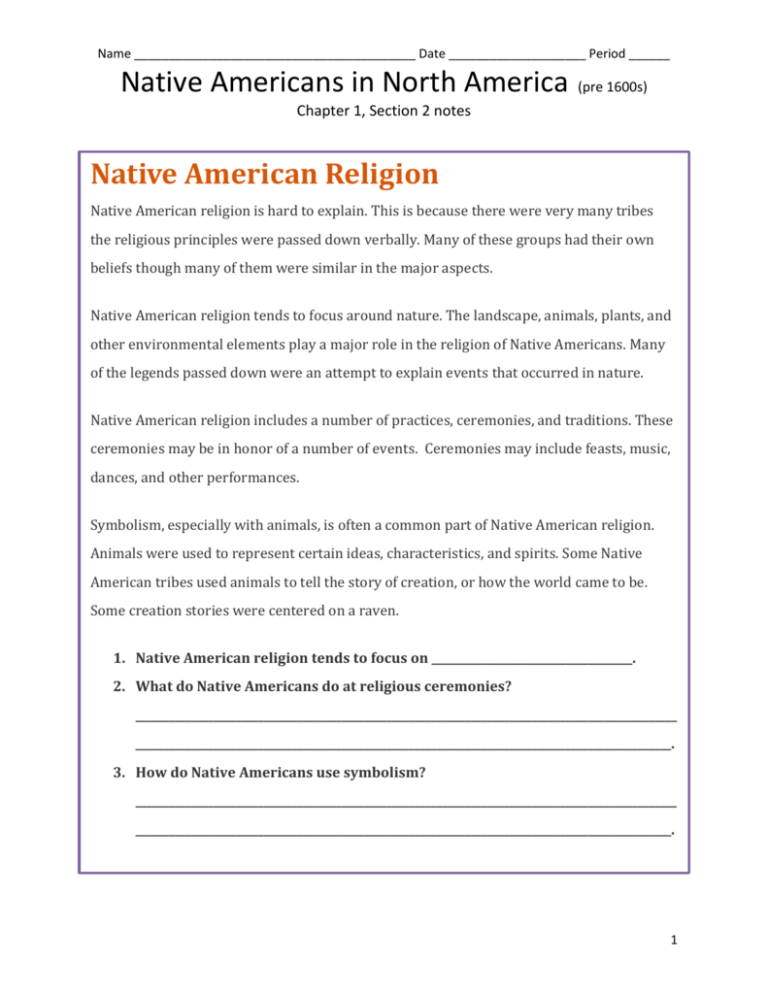
Name _________________________________________ Date ____________________ Period ______ Native Americans in North America (pre 1600s) Chapter 1, Section 2 notes Native American Religion Native American religion is hard to explain. This is because there were very many tribes the religious principles were passed down verbally. Many of these groups had their own beliefs though many of them were similar in the major aspects. Native American religion tends to focus around nature. The landscape, animals, plants, and other environmental elements play a major role in the religion of Native Americans. Many of the legends passed down were an attempt to explain events that occurred in nature. Native American religion includes a number of practices, ceremonies, and traditions. These ceremonies may be in honor of a number of events. Ceremonies may include feasts, music, dances, and other performances. Symbolism, especially with animals, is often a common part of Native American religion. Animals were used to represent certain ideas, characteristics, and spirits. Some Native American tribes used animals to tell the story of creation, or how the world came to be. Some creation stories were centered on a raven. 1. Native American religion tends to focus on ____________________________________. 2. What do Native Americans do at religious ceremonies? _________________________________________________________________________________________________ ________________________________________________________________________________________________. 3. How do Native Americans use symbolism? _________________________________________________________________________________________________ ________________________________________________________________________________________________. 1 Name _________________________________________ Date ____________________ Period ______ Native Americans in North America (pre 1600s) Chapter 1, Section 2 notes Native American Culture Perhaps no other group of people has quite the rich and storied culture as those of the Native Americans. They have a history rich in struggle, strife, and triumph. So many aspects of our modern life were adapted from the old Indian cultures practiced centuries ago. Many familiar symbols were originated by Native Americans. The teepee, totem pole, peace pipe, and moccasins are just a few examples, but each of these symbols was actually integral pieces of a larger picture that wove together the tapestry of Native American life. Everything from native plants and animals to housing to the weather became a part of the culture in Indian life. The animals were revered as spirits, and although they were hunted and killed, their skins and hides were used as clothing and drums, their meat was never wasted, and their spirits lived on in the mind of the tribes. Most native groups did not believe in land ownership as the lands were there to share. Though the land was shared, some groups used the land to grow crops. They cultivated and harvested plants and used for various things such as dyes for blankets. The rain and sun were considered to be Gods, giving a sign to the Indians as the seasons changed. Totem poles were a very integral part of Native American culture. The Indians believed that each person was assigned the spirit of a particular animal, and that their spirit was absorbed into this animal in death. The totem pole was a large, tall wooden carving of various animals, each representing a family member of a loved one who had passed away. Many people see dream catchers hanging from peoples’ car rearview mirrors, but few know their significance. The dream catcher is based on a legend told by the Lakota tribe. It symbolizes holding onto good things in life, while the holes in the catcher are there to filter out bad thoughts and feelings. Smoke signals are another interesting aspect of Native American culture. They were used to communicate to others over a long distance and are yet another symbol of the proud heritage of the Native American. 2 Name _________________________________________ Date ____________________ Period ______ Native Americans in North America (pre 1600s) Chapter 1, Section 2 notes 1. What are some familiar Native American symbols? _______________________________________________________ 2. How did Native Americans feel about animals? How do you know? ________________________________________________________________________ _______________________________________ 3. How did many Native Americans view land and crop ownership? ________________________________________________________________________ ________________________________________________________________________ ________________________________________________________________________ 4. What does a totem pole symbolize? ________________________________________________________________________ ________________________________________________________________________ 5. What does a dream catcher symbolize? ________________________________________________________________________ ________________________________________________________________________ 6. What does a smoke signal symbolize? ________________________________________________________________________ ________________________________________________________________________ 3 Name _________________________________________ Date ____________________ Period ______ Native Americans in North America (pre 1600s) Chapter 1, Section 2 notes Native American Women Women played a very important role in the life of the Native American. They were more than just mothers of the tribes’ children. They were builders, warriors, farmers, and craftswomen. Their strength was essential to the survival of the tribes. In most cases, the women were actually in charge of gathering materials and then building the homes for everyone. They maintained their homes’ roof, and created new houses for tribes to live in. This is an astonishing achievement, particularly for the women of their time. The men knew that women were the source of life, and provided a feeling of strength and consistency to their lives. The women in Native American tribes often helped their men to hunt down buffalo. Then, when the buffalo were harvested, the women were responsible for skinning, cutting, and cooking the animal. They also gathered firewood, cooked, and repaired clothing and shoes. Native American women were not simply homemakers. In fact, many tribes like the Lenape and the Iroquois were matrilineal. Ancestors were traced through the mother’s side; women took part in major decisions like choosing leaders and deciding whether or not to go to war. They served a great deal of important purposes and were essential to the tribe in other ways as well. Women made tools and weapons out of animal bone. Not only were there medicine men in the tribes but there were medicine women as well. In fact, many Native American tribes believed that the women had more healing power and were able to soothe ill souls with their chants and connection to the spirit world. Medicine women gathered herbs to create healing medicines for those who fell sick within the tribe. Additionally, most Native American women were master craftsman who made beautiful blankets, baskets, and pottery. Jewelry was another favorite. There was a feeling of mutual respect between the men and women of the tribes. They cared for their children and husbands, just like the modern woman does today. Without their help, it would have been very difficult for the Native Americans to survive. 4 Name _________________________________________ Date ____________________ Period ______ Native Americans in North America (pre 1600s) Chapter 1, Section 2 notes 1. What are examples of responsibilities women had inside of the home? ________________________________________________________________________ ________________________________________________________________________ ________________________________________________________________________ 2. What are examples of responsibilities women had outside of the home? ________________________________________________________________________ ________________________________________________________________________ ________________________________________________________________________ 3. What was the role of a medicine woman? ________________________________________________________________________ ________________________________________________________________________ ________________________________________________________________________ 5 Name _________________________________________ Date ____________________ Period ______ Native Americans in North America (pre 1600s) Chapter 1, Section 2 notes Spotlight on Native American Nations Powhatan Federation (1547 –1618) Powhatan was the leader, or chief, of the Powhatan federation of Indians, a group of some thirty tribes, that occupied Virginia in the 1600s. Originally, there were many different Algonquian tribes in Virginia, including the Powhatan, Pamunkey, Mattaponi, and Chickahominy tribes. They shared the same language and culture, but each village was independent from the others. In the 16th century, Chief Powhatan united all these villages into the Powhatan Confederacy. Many villages joined the Powhatan Confederacy willingly. Others were conquered by Chief Powhatan. His proper name was Wahunsenacawh and he was the father of Pocahontas. The Powhatan spoke an Algonquian language. Location Powhatan was actually the name of one of the towns where Wahunsenacawh lived, in the east end of the city of Richmond, Virginia. It was also the name of the adjacent river, which today is called the James River. When he created a powerful empire by conquering most of Tidewater Virginia, he called himself the "Powhatan", which is actually a title rather than his given name. 6 Name _________________________________________ Date ____________________ Period ______ Native Americans in North America (pre 1600s) Chapter 1, Section 2 notes They lived in small round houses called wigwams, or in larger Iroquoisstyle longhouses. Some Powhatan villages were palisaded (surrounded by log walls for protection), and each village had a council house and food storage building. The Powhatans were farming people. Powhatan women planted and harvested corn, squash and beans. Powhatan men hunted for deer, turkeys, and small game and went fishing on the shores. Powhatan foods included soup, cornbread, and stews. Powhatan warriors used tomahawks or heavy wooden war clubs. They also carried shields. Powhatan hunters used bows and arrows. Fishermen used nets and pronged spears to catch fish from their dugout canoes. 1. Where did the Powhatan live? ______________________________________________________ 2. What were their homes? _______________________________________________________________ 3. How did the Powhatan get their food? _________________________________________________________________________________________________ _________________________________________________________________________________________________ 4. What were the Powhatan known for? _________________________________________________________________________________________________ _________________________________________________________________________________________________ 7 Name _________________________________________ Date ____________________ Period ______ Native Americans in North America (pre 1600s) Chapter 1, Section 2 notes Iroquois Confederacy (1575-1787) The Iroquois Confederacy, made up of six Nations, was formed in about 1575. The Iroquois Nation includes the Onondaga, the Oneida, the Seneca, the Mohawk, the Cayuga, and the Tuscarora. In order to join the confederacy, each nation had to abandon cannibalism and advance “peace, civil authority, righteousness, and the great law.” Held together mainly by their desire to stand together against invasion, the tribes united in a common council composed of clan and village chiefs; each tribe had one vote, and unanimity was required for decisions. The joint group of 50 peace chiefs embraced all civil affairs at the intertribal level. The Iroquois League is the name for the cultural union of these nations; the Iroquois Confederation is the name for the political union. The Iroquois are from New York State. Near their palisaded villages (villages surrounded by walls made of wooden stakes or tree trunks for defense) which were often surrounded by moats, the Iroquois planted maize, squash, and beans--the Three Sisters. They hunted deer and bear, caught fish, tapped the sugar maples, and gathered a variety of plant foods. They lived in large bark longhouses, each house holding as many as sixty people and headed by a clan mother. The Iroquois Confederacy allied with the British during the Revolutionary War. Though the Iroquois Confederacy was dissolved after the British lost the Revolutionary War, the Iroquois League still exists today. The Iroquois have always prided themselves on diplomacy and even today the Iroquois travel the world speaking of peace. 5. What nations make up the Iroquois Confederacy? _________________________________________________________________________________________________ 6. Where did the Iroquois live? ______________________________________________________ 7. What were their homes? _______________________________________________________________ 8 Name _________________________________________ Date ____________________ Period ______ Native Americans in North America (pre 1600s) Chapter 1, Section 2 notes 8. How did the Iroquois get their food? _________________________________________________________________________________________________ _________________________________________________________________________________________________ 9. What were the Iroquois known for? _________________________________________________________________________________________________ _________________________________________________________________________________________________ 10. What is the difference between the Iroquois League and the Iroquois Confederacy? _________________________________________________________________________________________________ _________________________________________________________________________________________________ _________________________________________________________________________________________________ _________________________________________________________________________________________________ Algonquin The Algonquin are original natives of southern Quebec and eastern Ontario, in Canada. For most of the year they lived in settled villages of birch bark houses, called wigwams. During the winter, the village split up to go to hunting camps, and each Algonquin family built a smaller cone-shaped wigwam like this for their camp, also made from birch bark. Algonquin Indian tribe was famous for their birch bark canoes. Over land, the Algonquin used dogs as pack animals. (There were no horses in North America until colonists brought them over from Europe.) The Algonquin used sleds and snowshoes to help them travel in the winter. Algonquin women gathered plants to eat and did most of the child care and cooking. Men were hunters and sometimes went to war to protect their families. Both genders took part in storytelling, artwork and music, and traditional medicine. In the past, the Algonquin Indian chief was always a man, but today a woman can be chief too. The Algonquin were semi-nomadic hunter-gatherers. That means they didn't do much farming, and moved around a lot as they collected food for their families. Besides fish and 9 Name _________________________________________ Date ____________________ Period ______ Native Americans in North America (pre 1600s) Chapter 1, Section 2 notes meat, the Algonquin gathered berries and wild plants to eat. They also traded with neighboring tribes to get corn, and made maple syrup from tree sap. The Algonquin often fought with the Iroquois, but when they weren't at war with them, they were trading partners. The Algonquin traded beaver pelts and other furs for Iroquois corn and tobacco from the south. 1. Where did the Algonquin live? ____________________________________________________________ 2. What were their homes? ____________________________________________________________________ 3. How did the Algonquin get their food? _________________________________________________________________________________________________ _________________________________________________________________________________________________ 4. What were the Algonquin known for? _________________________________________________________________________________________________ 5. What was the Algonquin relationship with the Iroquois? _________________________________________________________________________________________________ _________________________________________________________________________________________________ Delaware/Lenape Natives The Delaware natives, also called the Lenape, originally lived along the Delaware River in the Delaware Valley in Eastern Pennsylvania and western New Jersey. They speak a form of the Algonquian language and are thus related to the Miami natives, Ottawa natives, and Shawnee natives. The Delaware were called "Grandfathers" by the other Algonquian tribes because of their belief that the Delawares were among the oldest groups in the Algonquian nation. Like the Algonquins, the Lenape Indians lived in bark houses called wigwams. The frame was made by bending branches to form a dome shape. These branches were tied together with vines or leather thongs. The wigwam was then covered by bark or hides. There was a hole at the top to let out smoke from the small fireplace inside. They constructed large fish baskets to gather the catch. Using bows and arrows, the men hunted a variety of animals, although deer, elk and bear were the Lenape’s largest prey. Deer were often hunted by surrounding or herding them into pens or rivers. This method involved many people forming into a large a circle as possible and by using fire or noise to drive the animals to the hunters where they could be easily killed. 10 Name _________________________________________ Date ____________________ Period ______ Native Americans in North America (pre 1600s) Chapter 1, Section 2 notes Trapping was another means by which the Lenape caught animals like beaver, otter, muskrat, raccoon, mink and wild cats. Turkey, eagle and other birds like partridge, pigeon, wild ducks and geese were also shot or caught in traps to be part of the Lenape diet. Women were responsible for the planting and harvesting of crops and gathering wild foods. Delaware/Lenape social system has matrilineal clans, that is, children belong to their mother's clan, from which they gain social status and identity. The mother's eldest brother was more significant as a mentor to the male children than was their father, who was of another clan. Leadership passed through the mother’s bloodline, and women elders could remove leaders of whom they disapproved. Agricultural land was managed by women and allotted according to the subsistence needs of their extended families. As British colonists immigrated to North America, the Delawares fled westward away from the land-hungry Europeans. While trying to escape the British colonists, the Delawares encountered the Iroquois natives, who struggled with the Delawares and drove them further west. Some Delaware natives came to live in eastern Ohio along the Muskingum River, while others resided in northwestern Ohio along the Auglaize River. Once in Ohio, the Delawares grew into a powerful tribe that often resisted the further advances of the Iroquois. 1. Where did the Delaware live? ____________________________________________________________ 2. What were their homes? ____________________________________________________________________ 3. How did the Delaware get their food? _________________________________________________________________________________________________ _________________________________________________________________________________________________ 4. What were the Delaware known for? _________________________________________________________________________________________________ 5. What was the Delaware relationship with the Iroquois? The Europeans? _________________________________________________________________________________________________ _________________________________________________________________________________________________ _________________________________________________________________________________________________ _________________________________________________________________________________________________ 11
